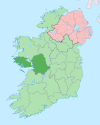Camus, County Galway
This article needs additional citations for verification. (June 2020) |
Camas
Camus | |
|---|---|
Village | |
| Coordinates: 53°22′23″N 9°33′32″W / 53.373°N 9.55888°W | |
| Country | Ireland |
| Province | Connacht |
| County | County Galway |
| Elevation | 54 m (177 ft) |
| Irish Grid Reference | L963370 |
| Camas is the official spelling.[1] | |
Camus or Camas is a small village in the Connemara Gaeltacht of County Galway, Ireland. It is between Casla and An Teach Dóite, and is divided into Camas Uachtair and Camas Íochtair, as well as several other townlands, such as Scríob, Gleann Trasna, Leitir Móir, and Doire Bhainbh.
The village has the highest percentage of Irish language speakers in the Gaeltacht.[citation needed]
Name
The name Camus/Camas (both versions are used, though the version Camus, which has been in use for generations in both Irish and English has been retained by the great majority of the population). The name refers to the shape of the nearby bay in which the tides come and go through the narrow strait at Dun Manus and enter Camus bay at an angle. The explanation of the name sometimes given - 'cam uisce' or crooked water - is etymologically unsustainable. Camus residents are known by their nickname of Maicíní (the etymology of this word is unclear, although it was common in south Conamara to give each village nicknames). Camus is also known in song as Camus na bhFoirnéis (Camus of the furnaces). It is believed that a small medieval foundry was operated close to the small bridge at the centre of the area in the 18th century.
Notable buildings
Camus is also the location for Screeb House (Screeb House is in Screeb, not Camus) built by Thomas Fuge in the 18th century, which is also a former residence for the Berridge family, the local landlords in the 19th century, and also the lodge for a large system of interconnected fishing lakes. Lord Dudley, Lady Dudley (founder of the Dudley Nurses) and Sir William Orpen also spent time in this house. Sir William Orpen painted some paintings in the area - "Old John's Cottage" was painted in the nearby house of John (Seán) & Mary Geoghegan in Doire Bhainbh in 1908 and he also painted "The Holy Well" with scenes from the Aran Islands and nearby An Teach Dóite (Maam Cross).


